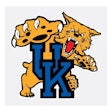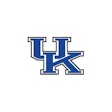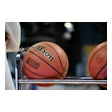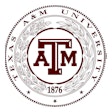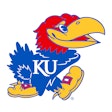Mobile units provide a relatively affordable way to benefit huge numbers of recreation-starved kids.
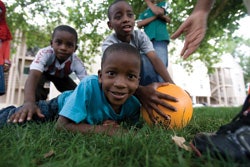 HOME GAMES Some cities have logged high participation rates when taking recreation supplies directly to low-income apartment complexes.
HOME GAMES Some cities have logged high participation rates when taking recreation supplies directly to low-income apartment complexes.Municipal agencies spend countless resources developing and marketing recreation centers, all in an effort to attract people to recreation programs. But there is another strategy: take the programs to the people. Some cities are utilizing mobile recreation as a relatively affordable means through which to create positive and lasting experiences for those residents who, for whatever reason, have traditionally been shorted on recreation opportunities within a given community.
Roseanne Daily, the mobile recreation program director for the city of Boise, Idaho, notes that the mobile recreation concept is not new, but says rec departments have most often used it for marketing purposes or for fee-based programs. Boise, however, is one of numerous cities throughout the country to have recently launched free mobile rec programs targeted specifically toward underserved youth populations. "They are not necessarily low-income areas, but areas that through surveys and other data we could see had groups of children that could not get to the established programs at our community centers," says Daily. "The idea is, we bring these services to them because they cannot get to us."
In August, officials in Alameda County, Calif., unveiled an office trailer that was converted into a mobile recreation unit and announced a similar tack, targeting "kids who, because of transportation or financial issues, may not have access to other recreational opportunities," says Alameda County Sheriff Greg Ahern.
Why is the Alameda County sheriff announcing the new recreation program? In his words: "This is a wonderful community-building and crime-prevention tool. I am a big believer in physical fitness. Kids who are active, fit and engaged in healthy activities are less likely to commit crimes."
That kind of interagency reciprocity - in both funding and purpose - is apparent in all mobile rec programs targeting underserved populations. It's why the Alameda sheriff's department donated the trailer; why the county's Deputy Sheriff's Activities League donated $15,000 in state block grant money to outfit the trailer with athletic equipment, Sumo wrestling outfits and a bungee course, and provided volunteers; and why the Hayward Area Recreation and Park District gladly offered to operate the program.
The success of Boise's mobile recreation unit - a 15-passenger van that was converted with storage bins and shelving - is similarly dependent on numerous collaborations. The city works with the two public school systems within its boundaries to coordinate two-week-long visits to Title I schools (those in which at least half the students qualify for free or reduced-price lunches). Local civic groups such as the Lions and Rotary clubs make modest charitable donations.
 MOLDING YOUNG LIVES The art component to Boise's mobile rec program includes more specialized equipment, such as clay, that kids might not otherwise have access to.
MOLDING YOUNG LIVES The art component to Boise's mobile rec program includes more specialized equipment, such as clay, that kids might not otherwise have access to.The city also partners with local universities. As part of a state-run youth health program, the University of Idaho provides annual funding for the mobile rec program, which in turn incorporates a nutrition education curriculum - including providing healthy snacks - into its daily schedule. Boise State University provides work-study and service-learning students to help operate the program. "Even the city of Boise has to work well as a team through the different departments to make this work," says Daily. "Without all these partnerships, the program wouldn't flow right."
It also wouldn't be financially viable. Thanks to those volunteer college students, the University of Idaho funding and the charitable donations, Boise's mobile recreation program costs the city approximately $35,000 a year (excluding Daily's salary, as running the program is only one part of her job description). Obviously, $35,000 is significant in this economy, and it did cost another $20,000 to $30,000 to buy and equip the van. But, as of Oct. 1, Daily and her staff had already recorded 57,000 visits in the 18 months since the program's inception. "This is a pretty inexpensive program for the impact that it makes," Daily says. "Staffing is always the issue. But if you can utilize those partnerships, you can really cut costs. Once you have all the startup equipment, art supplies are the only thing that need to be replenished on a quarterly basis, and maybe some of your athletic equipment once a year."
The program's success, especially at low-income apartment complexes, has Daily relishing the opportunity to expand it into a fleet of mobile rec units. "Parents are having a really hard time, and we're offering a free program that provides a safe environment," says Daily. "We wish we could do more, but the resources aren't there."
Michael Maine, a recreation coordinator for the Hayward Area Recreation District who helps run the mobile program, would likewise welcome growth, especially given the program's already high participation. "We'd like to expand it along with the health department," says Maine, adding that he envisions free health screenings for the 6- to 18-year-olds targeted by the program. "That's a work in progress at this time, but there's a lot of funding out there if you can combine physical and educational health activities."
Adding such components, says Maine, would merely serve to expand the program's focus, not redefine it. "What we're trying to do is keep kids off the street and give them an outlet," he says. "We're giving them a safe and secure location to come and enjoy just being a kid. And when they do get healthier because of it, hopefully they can learn to make more positive life choices."
But Daily and Maine both stress that the programs require much more than simply parking the mobile unit and watching from the sidelines as kids play. The programs are highly structured. In Boise, for example, 30 to 45 minutes of organized physical activity are followed by a break period, a snack period and then the health education component. Then there's the option for more organized physical activity or an arts program led by a qualified art instructor. "We try to make sure the art project is something they would not normally be able to do," says Daily. "They're not just coloring; they're working with clay or painting. We try to provide a high-quality art program."
And since these programs tend to best suit youth populations, a high level of teaching and socializing must occur. "Yes, these kids have something to do so they're not getting into trouble, but they can also say, 'Hey, here are some adults that are pretty cool, who care about me and who keep coming back.' Some of these kids don't have that," says Daily. "There's a discipline aspect, too. There are behavioral boundaries, and if you can't act within the boundaries, then you can't participate. It goes far beyond just 'let's go play.'"


















